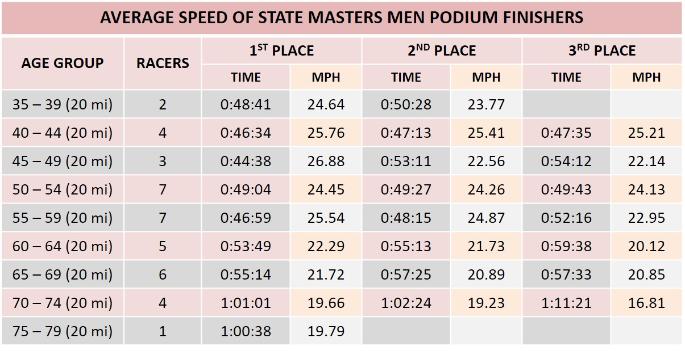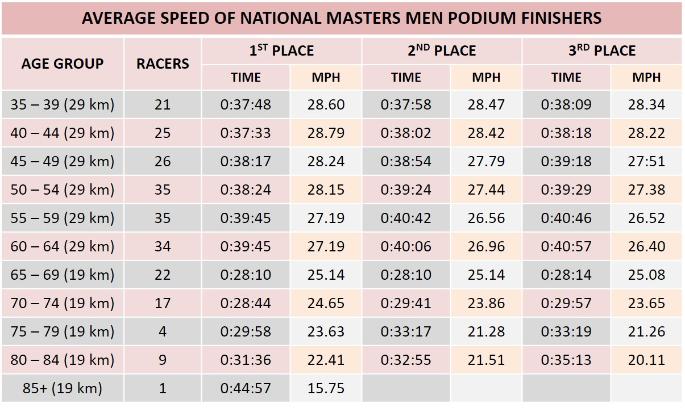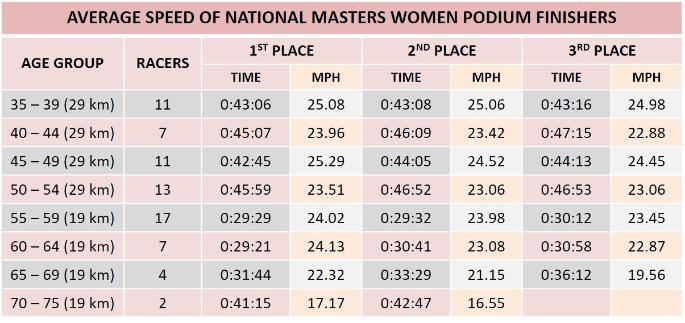Are you fast enough?
When chatting with Masters-aged recreational cyclists about racing, the very first question I’m asked is “How fast do I have to go?” That’s an important question. There is a huge difference between a casual, two-hour, 15 mph average ride, that barely breaks a sweat, and a 20-25+ mph all-out effort for 15 minutes, 30 minutes, or an hour that leaves you gasping for breath afterwards.
And remember that speed is not the only factor that determines whether or not you’re competitive on race day. You can control several factors, such as your gear, training, and race fitness. But, there are a number of other factors that are outside your control:
- Weather (temperature, precipitation, and wind speed)
- Course profile (flat or hilly)
- Number of competitors (a couple of entries to dozens in each age group)
So, all things being equal, how fast do you have to go?
![]() For the Beginner competitive cyclist, just ride as fast you can go and still finish the race. Try to stay in an aerodynamic crouch over the handlebars and pedal in the biggest gear that you can maintain. Don’t start too fast, which is difficult the first time, because of the excitement factor.
For the Beginner competitive cyclist, just ride as fast you can go and still finish the race. Try to stay in an aerodynamic crouch over the handlebars and pedal in the biggest gear that you can maintain. Don’t start too fast, which is difficult the first time, because of the excitement factor.
![]() For the Intermediate and Advanced racers, the following charts show the average speed of the podium finishers in Masters age-groups at the local, state, regional, and national time trial races that I entered during 2017.
For the Intermediate and Advanced racers, the following charts show the average speed of the podium finishers in Masters age-groups at the local, state, regional, and national time trial races that I entered during 2017.
Note that the number of competitors at the local and state level are roughly the same, but double and triple in size at the regional and national races, respectively. Consequently, as the number of competitors increases, the speed/time differences between the podium finishers gets smaller and smaller.
For example, in the local 65+ age group race, the time difference between first and second place was almost three minutes. In the national 65-69 age group race, the time difference between first and second place finishers was less than a single second. The winner was determined by hundredths of a second. In fact, the time difference between the top 10 finishers was only 58 seconds.
LOCAL 12 MILE TIME TRIAL
Course: Flat
Weather: 59 degrees, partly cloudy, 67% humidity, 8 mph wind
STATE CHAMPIONSHIP 20 MILE TIME TRIAL
Course: Flat
Weather: 75 degrees, sunny, 65% humidity, 6 mph wind
REGIONAL CHAMPIONSHIP 20 & 40 KILOMETER TIME TRIAL
Course: Flat
Weather: 81 degrees (felt like 85 degrees), partly cloudy, 74% humidity, 5 mph wind
NATIONAL CHAMPIONSHIP 19 & 29 KILOMETER TIME TRIAL
Course: Rolling hills
Weather: 85 degrees (felt like 87 degrees), sunny, 49% humidity, 5 mph wind
SUMMARY
Being fast enough to finish on the podium in a Masters age-group race, whether at the state, regional, or national level is only, in rare cases, the result of pure natural ability. To maintain speeds in excess of 20 mph for half an hour to an hour requires several years of training encompassing thousands of training miles each year.
Have questions about racing? Not sure if you can be competitive at your age? Have questions or concerns about any aspect of racing at the local, state, regional, or national level? Chances are pretty good that I’ve faced the same challenges during the last 20+ years of training and racing. Ask me anything!
Categories
Archives








